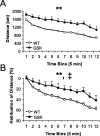Transgenic mice overexpressing glycogen synthase kinase 3beta: a putative model of hyperactivity and mania
- PMID: 16943560
- PMCID: PMC6675350
- DOI: 10.1523/JNEUROSCI.5216-05.2006
Transgenic mice overexpressing glycogen synthase kinase 3beta: a putative model of hyperactivity and mania
Abstract
Lithium is used as treatment for bipolar disorder with particular efficacy in the treatment of mania. Lithium inhibits glycogen synthase kinase 3beta (GSK-3beta) directly or indirectly via stimulation of the kinase Akt-1. We therefore investigated the possibility that transgenic mice overexpressing GSK-3beta could be of relevance to model bipolar disorder. Transgenic mice showed hypophagia, an increased general locomotor activity, and decreased habituation as assessed in an open field, an increased acoustic startle response, and again decreased habituation. The forced swim test revealed a reduced immobility in transgenic mice, but this is probably related to the hyperactivity of the animals. There were no differences in baseline and stress-induced increases of plasma adrenocorticotrophic hormone and corticosterone levels. Molecular analysis suggests compensatory mechanisms in the striatum of these transgenic mice for the overload of active GSK-3beta by dimming the endogenous GSK-3beta signaling pathway via upregulation of Akt-1 expression. Brain-derived neurotrophic factor protein levels were increased in the hippocampus of the transgenic mice. This suggests some kind of compensatory mechanism to the observed reduction in brain weight, which has been related previously to a reduced size of the somatodendritic compartment. Together, in mice overexpressing GSK-3beta, specific intracellular signaling pathways are affected, which is accompanied by altered plasticity processes and increased activity and reactivity, whereas habituation processes seem to be decreased. The behavioral observations led to the suggestion that the model at hand recapitulates hyperactivity as observed in the manic phase of bipolar disorder.
Figures




Similar articles
-
The mood stabilizing properties of AF3581, a novel potent GSK-3β inhibitor.Biomed Pharmacother. 2020 Aug;128:110249. doi: 10.1016/j.biopha.2020.110249. Epub 2020 May 26. Biomed Pharmacother. 2020. PMID: 32470749
-
Glycogen synthase kinase-3beta heterozygote knockout mice as a model of findings in postmortem schizophrenia brain or as a model of behaviors mimicking lithium action: negative results.Behav Pharmacol. 2008 May;19(3):217-24. doi: 10.1097/FBP.0b013e3282feb099. Behav Pharmacol. 2008. PMID: 18469539
-
Glycogen Synthase Kinase-3β as a Putative Therapeutic Target for Bipolar Disorder.Curr Drug Metab. 2018;19(8):663-673. doi: 10.2174/1389200219666171227203737. Curr Drug Metab. 2018. PMID: 29283064 Review.
-
Lithium blocks stress-induced changes in depressive-like behavior and hippocampal cell fate: the role of glycogen-synthase-kinase-3beta.Neuroscience. 2008 Mar 27;152(3):656-69. doi: 10.1016/j.neuroscience.2007.12.026. Epub 2007 Dec 23. Neuroscience. 2008. PMID: 18291594
-
The role of glycogen synthase kinase-3beta in schizophrenia.Drug News Perspect. 2007 Sep;20(7):437-45. doi: 10.1358/dnp.2007.20.7.1149632. Drug News Perspect. 2007. PMID: 17992266 Review.
Cited by
-
Lithium's role in neural plasticity and its implications for mood disorders.Acta Psychiatr Scand. 2013 Nov;128(5):347-61. doi: 10.1111/acps.12139. Epub 2013 Apr 26. Acta Psychiatr Scand. 2013. PMID: 23617566 Free PMC article. Review.
-
Gsk3 Signalling and Redox Status in Bipolar Disorder: Evidence from Lithium Efficacy.Oxid Med Cell Longev. 2016;2016:3030547. doi: 10.1155/2016/3030547. Epub 2016 Aug 18. Oxid Med Cell Longev. 2016. PMID: 27630757 Free PMC article. Review.
-
Boosting Neurogenesis in the Adult Hippocampus Using Antidepressants and Mesenchymal Stem Cells.Cells. 2022 Oct 14;11(20):3234. doi: 10.3390/cells11203234. Cells. 2022. PMID: 36291101 Free PMC article. Review.
-
Circadian genes, rhythms and the biology of mood disorders.Pharmacol Ther. 2007 May;114(2):222-32. doi: 10.1016/j.pharmthera.2007.02.003. Epub 2007 Feb 28. Pharmacol Ther. 2007. PMID: 17395264 Free PMC article. Review.
-
Genetic and clinical factors predict lithium's effects on PER2 gene expression rhythms in cells from bipolar disorder patients.Transl Psychiatry. 2013 Oct 22;3(10):e318. doi: 10.1038/tp.2013.90. Transl Psychiatry. 2013. PMID: 24150227 Free PMC article.
References
-
- Beaulieu JM, Sotnikova TD, Marion S, Lefkowitz RJ, Gainetdinov RR, Caron MG. An Akt/beta-arrestin 2/PP2A signaling complex mediates dopaminergic neurotransmission and behavior. Cell. 2005;122:261–273. - PubMed
-
- Beck KD, Powell-Braxton L, Widmer HR, Valverde J, Hefti F. Igf1 gene disruption results in reduced brain size, CNS hypomyelination, and loss of hippocampal granule and striatal parvalbumin-containing neurons. Neuron. 1995;14:717–730. - PubMed
Publication types
MeSH terms
Substances
LinkOut - more resources
Full Text Sources
Medical
Molecular Biology Databases
Miscellaneous
